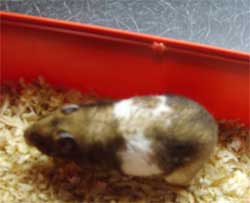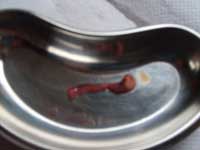| |
Hamster with pyometra
What is Pyometra? Pyometra is an infection of the uterus: a womb infection. Pyometra can be a life threatening condition and is characterized by an accumulation or discharge of pus, and or blood from the uterus. There are two types of pyometra seen in the hamster. There is an open pyometra, and a closed pyometra. Pyometra is a condition of the womb in which the womb becomes infected, it is caused by a bacterial infection or hormonal and structural changes in the uterus lining. Pyometra is a condition that can affect the female hamster even if she has never been used to breed from. It is a disease seen mostly in the older female but can also affect younger hamsters. The bacteria involved in pyometra are thought to enter the uterus through the cervix when it is open and often occurs around the time of normal oestrus.
Swelling of the abdomen in the female may suggest pyometra. Although other medical conditions may cause the abdomen to become distended, these are but not limited to Ascites, Abscess, Tumors, Cysts, Fecal impaction, Cancer of the ovaries.
A hamster with an open pyometra:
The most perceptible signs of a hamster with an open pyometra may be seen as discharge of pus and or blood from the vulva. If the cervix is open the infected material can drain from the body. The infection can then be caught in the early stages making diagnosis and treatment much simpler.
Contrary to the belief of many people, hamsters do not menstruate (have periods) any discharge of blood from the vulva must be investigated as this may suggest an infection.
A hamster with a closed pyometra:
 In this video it appears the female hamster may be pregnant. It is the accumulation of fluid inside the uterus that causes the abdomen to become considerably swollen.
In this video it appears the female hamster may be pregnant. It is the accumulation of fluid inside the uterus that causes the abdomen to become considerably swollen. |
However, a closed pyometra is a more serious condition because the cervix is closed there is no outlet for the infection to drain from the body. Pus then accumulates inside the infected uterus, and over a short period of time the build up of infected material causes the abdomen to become swollen, and considerably distended. A closed Pyometra can be difficult to diagnose or detect until it is in the advanced stages of abdomen distension as there is no, or very little, noticeable discharge from the opening. However, symptoms in both cases may include loss of appetite increased drinking and urinating. Bacteria and other toxins may leak across the uterine walls and then into the bloodstream causing Sepsis: (blood poisoning) if urgent treatment is not sought. This can happen in both cases of a closed or an open pyometra. Once this occurs other organs such as the liver may not be able to cope in filtering out the toxins. Toxins then accumulate in the blood and eventually the brain. Signs of a build-up of toxins in the blood may include neglect of appearance, unresponsiveness, irritability, a refusal to eat and drink loss of balance, stumbling, shaking, coma and eventually death. Or the uterus may eventually rupture and the infection escapes into the abdomen causing peritonitis.
Advances have been made in treating hamsters with pyometra, see your vet if any of these symptoms become apparent. The only option in many cases may be the surgical removal of the uterus, this will remove the infection and prevent uterine rupture, and of course any recurrence of the disease.

|

|

|

|
A hamster with a closed pyometra. The abdomen becomes distended as the uterus fills with infected fluid. |
This is the same hamster (in the video above) after a
trans-abdominal hysterectomy. (Surgical removal of the uterus.) |
The image above shows the very enlarged uterus removed from the hamster. |
This image shows the actual size a hamsters uterus should be. |
|
|


